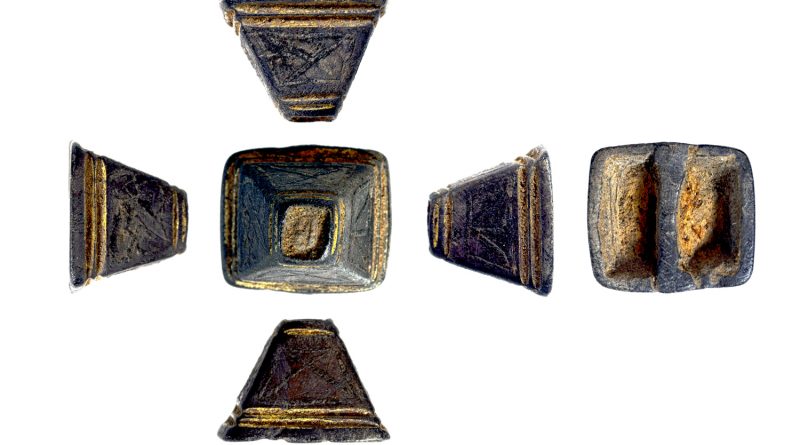A story about one of my finds
Some finds are to be expected. For example, if a site is known to have given up finds of a certain type or period then you could expect more to turn up. However, the most interesting items can be those that were totally unexpected. This is the story of one such find, which I unearthed early last year.
I most certainly can’t say the same about the weather in 2021 but in 2020 it started off quite good. In January I was out on the 5th, 12th and 19th, on each occasion with my club. In February outings were held on the 16th and 23rd and in March on the 1st and 8th. Then, of course, the lockdown started and my club had only one more outing during the whole of 2020.
Plenty of scrap metal and then something special
The find I refer to now turned up on 16 February. My club was on a very large field that had recently been ploughed. It was too rough to detect in some places but other areas had been flattened down a bit by rain the previous day. During the morning session I’d found a small Roman grot, which isn’t much but better than nothing. After lunch I had a few decent sounding signals but they all turned out to be bits of scrap metal.
It would be around 2 o’clock when I dug up something I thought I recognised. However, I had to put on my glasses to be sure. Now that I could see it clearly I could hardly believe my eyes. It was an Anglo-Saxon pyramid mount (see the illustrations). These things aren’t particularly rare but my club has had access to this field for around 15 years and the mount was the first find that dates from the Anglo-Saxon period.
Did it count as Treasure?
When I arrived home I studied the mount more closely. They are usually 12-15mm square at the base, the sides can be decorated or plain, the top is inset with a garnet and they are almost invariably silver-gilt. My find was intact except for the garnet but appeared to me to be gilded copper-alloy rather than silver-gilt. If it was copper-alloy it would not count as a Treasure find. However, I couldn’t be certain about its composition, so to be on the safe side I reported it as Treasure. Within a couple of months I heard from the FLO that it was silver-gilt and it had been given a Treasure reference number. The PAS reference is SWYOR-CEFC54.
If in doubt, report finds
This proves what many detectorists already know: totally unexpected finds can and do turn up just about anywhere. It also highlights that fact that if there is any doubt whatsoever about the composition of a find then it needs to be reported. No harm is done if it turns out to be base metal. However, if at some time in the future you realise you have a find in your collection that should have been reported then you could be in trouble.
Given a Treasure reference number
My find was speedily given a Treasure reference number because York Archaeological Trust had expressed an interest in acquiring it. Presumably, it was regarded as a worthwhile addition to the Anglo-Saxon collections already in museums situated in York.
Yorkshire Post phone me with result of Treasure inquest
On 25 January I received a letter from the office of the Senior Coroner for North Yorkshire and York, letting me know that an inquest on the mount would be held on the 1st of February. Due to the fact that the inquest would be held in North Yorkshire and travel was impossible because of the Covid restrictions, I did not attend. However, a reporter from the Yorkshire Post telephoned me and said the coroner had declared my find to be Treasure. I spoke to the reporter for about ten minutes, telling her about the circumstances surrounding the find and other snippets about finds and detecting in general.
Connection with Sutton Hoo
Mounts like the example I found are thought to have been attached to the scabbard of Anglo-Saxon swords. Evidence for this comes from the burial of the ship at Sutton Hoo. Three large mounds were excavated there; two contained very little but inside the third was a ship and some utterly superb Anglo-Saxon artefacts. A pair of mounts, similar but much finer than the one I found, were discovered close to a sword hilt. It has been suggested they could have adorned a scabbard. Date wise, they could be late 6th to 7th century. Leading on from this, at this moment in time my find is rather topical, for a film has just been released that focuses on the excavation of the mound at Sutton Hoo.
What I find most amazing about the Sutton Hoo burial is that for generations afterwards people in the surrounding area will have known that a ship and treasure was in the mound. Yet no-one attempted to dig into it! In Egypt most of the tombs of Pharos were speedily robbed out. Does this mean that the Anglo-Saxons were more honest? I don’t know. Perhaps generation after generation guarded the mound until a time came when the content was forgotten. Whatever is the case, it was left intact until the 20th century, when it was opened up to reveal its wonderful hidden secret.


Good article, made for an interesting read and nice find.